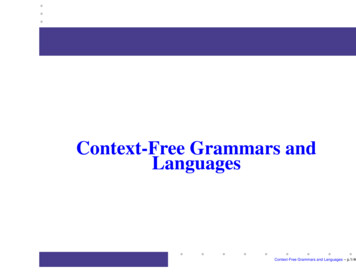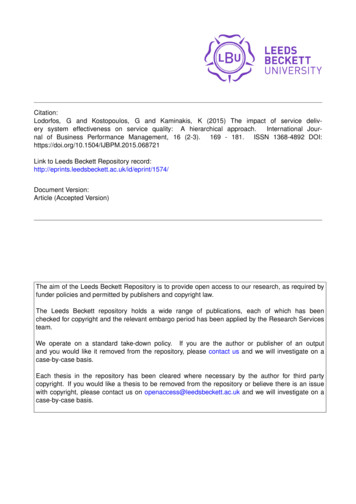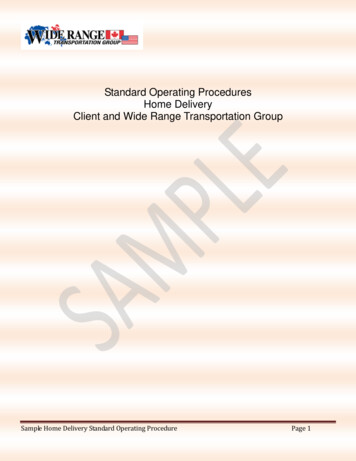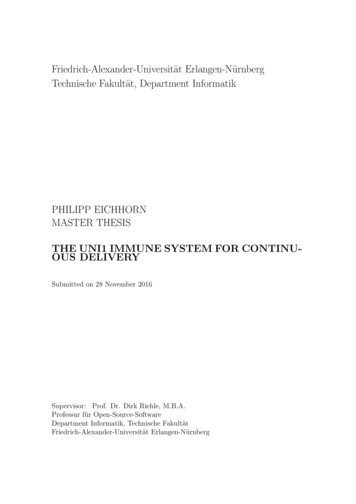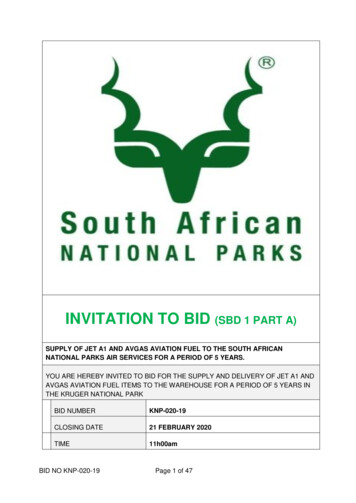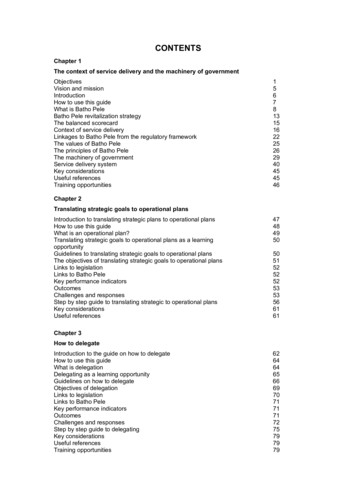
Transcription
CONTENTSChapter 1The context of service delivery and the machinery of governmentObjectivesVision and missionIntroductionHow to use this guideWhat is Batho PeleBatho Pele revitalization strategyThe balanced scorecardContext of service deliveryLinkages to Batho Pele from the regulatory frameworkThe values of Batho PeleThe principles of Batho PeleThe machinery of governmentService delivery systemKey considerationsUseful referencesTraining opportunities156781315162225262940454546Chapter 2Translating strategic goals to operational plansIntroduction to translating strategic plans to operational plansHow to use this guideWhat is an operational plan?Translating strategic goals to operational plans as a learningopportunityGuidelines to translating strategic goals to operational plansThe objectives of translating strategic goals to operational plansLinks to legislationLinks to Batho PeleKey performance indicatorsOutcomesChallenges and responsesStep by step guide to translating strategic to operational plansKey considerationsUseful references4748495050515252525353566161Chapter 3How to delegateIntroduction to the guide on how to delegateHow to use this guideWhat is delegationDelegating as a learning opportunityGuidelines on how to delegateObjectives of delegationLinks to legislationLinks to Batho PeleKey performance indicatorsOutcomesChallenges and responsesStep by step guide to delegatingKey considerationsUseful referencesTraining opportunities626464656669707171717275797979
Chapter 4Service delivery charterIntroduction to service delivery charterHow to use this guideWhat is a service delivery charter?Specimen of a service delivery charterService delivery charter as a learning opportunityGuidelines for developing a service delivery charterThe objective of developing a service delivery charterLinks to Batho PeleLinks to legislationCode of conductKey performance indicatorsOutcomesChallenges and responsesStep by step guide on developing a service delivery charterSome key considerationsUseful referencesTraining pter 5How to develop service standardsIntroduction to setting service standardsHow to use this guideWhat are service standards?Service delivery charterPre-requisites for setting service standardsSetting service standards as a learning opportunityLevels and types of standardsThe balanced scorecardLevels of standardsObjectivesLinks to legislationLinks to Batho PeleKey performance indicatorsOutcomesChallenges and responsesApproaches to developing service standardsStep by step guide to setting service standardsKey considerationsUseful 14115117124125Chapter 6How to consultIntroduction to how to consultWhy is consultation important in the public service?How to use this guideWhat is consultation?Consultation as a learning opportunityGuidelines for consultationThe objectives of consultationLinks to Batho PeleLinks to legislationKey performance indicators126127127128128130133134134134
Outcomes of consultationChallenges and responsesStep by step guideKey considerationsUseful references135135136157158Chapter 7Wayfinding and signageIntroduction to how to wayfinding and signageHow to use this guideWhat is wayfinding?The objectives of a wayfinding systemLinks to legislationLinks to Batho PeleOutcomesKey performance indicatorsGuidelines for an effective wayfinding systemMaking your own signsLanguage usage on signsSign categoriesCatering for the functionally illiterate and disabled personsStep by step guide to developing a wayfinding systemKey considerationsUseful 6189191Chapter 8Handling complaintsIntroduction to handling complaintsHow to use this guideWhat is a complaint?Complaints handling as a learning opportunityGuidelines for complaints handlingObjectives of setting aLinks to legislationLinks to Batho PeleKey performance indicatorsOutcomesChallenges and responsesStep by step guideKey considerationsUseful 09Chapter 9Self-AssessmentIntroduction to self-assessmentHow to use this guideWhat is self-assessment?Self-assessment as a learning opportunityGuidelines for self-assessmentThe objectives of self-assessmentLinks to Batho PeleKey performance indicatorsOutcomes of self-assessmentChallenges and responsesStep by step guideKey considerations210211211212212213213214214214220229
Chapter 10Peer reviewIntroduction to peer reviewHow to use this guideWhat is peer review?Peer review as a learning opportunityGuidelines for peer reviewThe objectives of peer reviewDifferent forms of peer reviewAreas of application for peer reviewExample of peer reviewExample of institutional peer reviewLinks to Batho PeleLinks to legislationKey performance indicatorsOutcomes of peer reviewChallenges and responsesStep by step guide to conducting peer reviewSome key considerationsUseful 42242245250250
CONTENTSOBJECTIVES1VISION AND MISSION5INTRODUCTION6HOW TO USE THIS GUIDE7WHAT IS BATHO PELE8BATHO PELE REVITALISATION STRATEGY13THE BALANCED SCORECARD15CONTEXT OF SERVICE DELIVERY16LINKAGES TO BATHO PELE FROM THE REGULATORY22FRAMEWORKTHE VALUES OF BATHO PELE25THE PRINCIPLES OF BATHO PELE26THE MACHINERY OF GOVERNMENT29SERVICE DELIVERY SYSTEM40KEY CONSIDERATIONS45USEFUL REFERENCES45TRAINING OPPERTUNITIES46
1OBJECTIVESThe Handbook strivesThe broad objective of the Batho Pele Handbook on Service Delivery isto deepen theto help improve public service delivery by supporting the transformationunderstanding ofof the public service into a citizen-orientated organisation, through aBatho Peledeeper understanding and application of Batho Pele.The specific objectives of the handbook are to:clarify the context of public service delivery;make Batho Pele a reality in public service delivery;help bridge the gap between “knowing” and “doing”; andput Batho Pele in action.The Handbook strives to deepen the understanding and impact ofBatho Pele by demonstrating that Batho Pele goes beyond the eightprinciples. It needs to be embedded in the core of service delivery,namely, in the envisioning and planning phases, from whence it can bewoven into the very fabric of public service delivery.The intended outcome of the Handbook is a fully functional publicservice that is able to deliver against the needs and expectations of thepeople. This will bring about a more positive perception of the publicservice by staff and citizens alike, which is the ultimate dynamicrequired to effect the transformation process. When the consumers ofgovernment services start saying that government is providing for theirneeds, the transformation process will be well entrenched.Frontline serviceThe general public everywhere in the world basis its perception ofproviders are thegovernment on the nature and quality of the services it experiences at“face” of governmentthe hands of public servants. The “face” of government is the faceand/or voice of the frontline service providers.This is all people experience and if the service is poor or unfriendly,then government is immediately constituted to be inefficient andbureaucratic. If the service is bad, government is bad and if the serviceis good, government is good, it is as simple as that. This is true theworld over and it is no different in South Africa.By helping to instil a culture of efficient, effective and friendly servicedelivery in the public service, this Handbook hopes that the spirit of
2Batho Pele will permeate the entire public service and put a smile onthe “face” of government and its customers.Your “smile” mustHowever, the “smile” must not be an inane grin or a superficial “mask”.come from the heart –It must be real. It must come from the heart. It must stem from ait must not be a maskgenuine desire to put “People First”.A CALL TO ACTIONIn his state of the nation address in May 2002, President Mbeki callson all South Africans to “Arise and Act – Vuk’ uzenzele!” and makesthe pledge that government “will strive to give real meaning to thestrategic challenge facing the Public Service – Batho Pele!”He stresses that “the struggle to eradicate poverty andunderdevelopment in our own country is fundamental to theachievement of our own national goal to build a caring and peoplecentred society.” This is how we need to understand Batho Pele. It is atthis fundamental level of change and transformation that Batho Pelecan make a real impact.The President acknowledges that much has been achieved since 1994and that, as a country and as a public service, we have travelled a longway down the road of transformation: “gradually, step by step, we areprogressing towards the achievement of the historic goal of theeradication of a centuries-old legacy of colonialism, of racism andapartheid.”As a proud South African the President praises us of all that has beenachieved, in health care, in welfare, in housing, in police services, inthe provision of clean water and electricity, in education. But hereminds us that the recognition we have received from the nations ofthe world for having “established ourselves as a winning nation, as apeople determined to succeed, places an obligation on us in fact tosucceed.”“ no one, and I meanAnd he goes on to state emphatically that as a country we have all theno one, should do foringredients to make faster progress, but emphasises that the mostus what we should doimportant ingredient “is our collective appreciation that no one, and Ifor ourselves”mean no one, can do for us what we should do for ourselves.”This is the State President’s call to action: “in the spirit of Vuk’
3uzenzele, we must arise and act in partnership across the nation” tobuild a citizen-centred public service and a people centred society.Vuk’ uzenzele means “arise and act” not “arise and talk” or “arise andthink” or even “arise and plan”. Clearly, talking, thinking and planningare all actions, but, in the spirit of the President’s address, what he isasking us to focus on is “doing” things that will make a difference topeople’s lives.The President’s words are perfectly aligned to current trends in publicmanagement to move away from a submissive and even subservientpublic service, to a strong, self-confident public service that accepts theresponsibility for the success and prosperity of the people it serves – apublic service that is prepared to lead from the front, while beingsensitive to the needs of the people.What an opportunity for the public service to embrace the fullimplications of Batho Pele and answer this call with new commitmentand heightened levels of service delivery!The time is now and we must rise to the occasion with the fullrealisation that, as public servants, we can alter the course of historyand prove to the world that we are a proud, successful and unitednation that will not succumb to the legacies of the past.Let us stand proud as public servants and commit ourselves “to enrichthe quality of services we render and make people-centred and peopledriven development a reality.” Let us respond with vigour to the call –‘Vuk’ uzenzele!’Efficient and effectiveThe guides in this Handbook are intended to help managers implementpublic service deliverystrategies to improve service delivery. They are not intended to bewill help lift from theprescriptive, but rather to help managers come to a bettershoulders of theunderstanding of Batho Pele and guide them through some of the morepeople the intolerableimportant processes to improve service delivery. Managers are notburden of poverty andexpected to follow these guidelines slavishly, but are ratherunderdevelopmentencouraged to be innovative in adapting these guidelines to suit theirparticular needs.In order to assist managers the DPSA has introduced a help line tohandle queries and uncertainties. Please call us on
4bathopelehandbook@dpsa.gov.za and we shall be only too happy tolisten and help you with any issues that may be hampering the optimalperformance of your component. We would also be very grateful forany comments you may have on the content, format or any otheraspect of the Handbook. Our intention is that it should be as useful aspossible and we welcome your views.
5VISION AND MISSION OF THE PUBLIC SERVICE
6INTRODUCTION TO CHAPTER 1When the new South African Government was elected to power in1994 it had a special mandate to provide appropriate services to all thepeople of the country. This was, still is and will continue to be amassive responsibility of government and one that requires totalcommitment by people at all levels of government, if it is going to befulfilled.A promise made is a promise that has to be kept.The new government made a promise to the people of South Africathat they would serve the people without discrimination, respecting thedignity of all and ensuring that the needs of the majority of thepopulation, who had been disadvantaged in the past, are met efficientlyand effectively.The nine ConstitutionalThis promise is unequivocally spelt out in the South Africanprinciples that areConstitution of 1996, which stipulates that the public service “must beintended to guide thegoverned by the democratic values and principles enshrined in thetransformation of theConstitution, including the following principles:public service from(a) A high standard of professional ethics must be promoted andrules-bound to resultsdrivenmaintained.(b) Efficient, economic and effective use of resources must bepromoted.(c) Public administration must be development-oriented.(d) Services must be provided impartially, fairly, equitably and withoutbias.(e) People’s needs must be responded to, and the public must beencouraged to participate in policy-making.(f) Public administration must be accountable.(g) Transparency must be fostered by providing the public with timely,accessible and accurate information.(h) Good human resource management and career developmentpractices, to maximise human potential, must be cultivated.(i) Public administration must be broadly representative of the SouthAfrican people, with employment and personnel managementpractices based on ability, objectivity, fairness, and the need toredress the imbalances of the past to achieve broadrepresentation.”
7These principles are intended to guide the transformation of the publicservice, from being a rules-bound, bureaucratic entity, concerned withthe administration of rules and regulations, to a dynamic, results-drivenorganisation, committed to delivering appropriate services to thepeople.The RegulatorySince 1994 government has passed a substantial body of enablingFramework is a bodylegislation to create an environment conducive to the rendering ofof enabling legislationappropriate services to all the people of South Africa. This body ofto facilitate thelegislation is referred to as the Regulatory Framework.transformationprocessTo support the implementation of the service delivery mandatescontained in the Regulatory Framework, government introduced theTransformation isnew Public Service Management Framework (PSMF).supported by thePublic ServiceWhile the PSMF incorporates a range of integrated managementManagementinterventions to help managers deliver the services promised byFrameworkgovernment, its fundamental message to all public servants is toconsult with their end-users to establish their needs and how best toprovide for these needs. It urges managers in the public service to beinnovative in service delivery, rather than following existing proceduresslavishly.However, it soon became evident that, despite government’scommitment to service delivery, its promise of a better life for all wouldnot be met unless a culture of service delivery, which put the“customer” first, could be inculcated throughout the entire publicservice.HOW TO USE THIS GUIDEThe objective of this guide is to explain the context of service deliveryand the machinery of government to help operational managers plan,implement and monitor initiatives to inculcate Batho Pele and improveservice delivery.What you can expectto learn from this guideThis guide will give you an understanding of:the machinery of government;a service e delivery system for the public service;the context of public service delivery;
8the links between the Regulatory Framework and Batho Pele;the values that underpin Batho Pele;what Batho Pele is;the Batho Pele Revitalisation Strategy which will reveal the deepermeaning of Batho Pele;the opportunities that exist for operational managers and frontlinestaff to make the transformation of service delivery a reality;the Balanced Scorecard and how it can be used to enhanceservice delivery and;the citizen as customer.Read the diagrams inDiagrams and flow charts have been included to provide a conceptualconjunction with thepicture of the processes of service delivery and their linkages. Theseaccompanying textillustrations should be read in conjunction with the text to deepenunderstanding.WHAT IS BATHO PELE?To promote this notion of “putting people first” and to provide aframework for the transformation of public service delivery, governmentintroduced the concept of Batho Pele, “people first” in 1997. This notionwas expanded in the White Paper on Transforming the public service,also known as the Batho Pele White Paper, which provides a policyframework to ensure that Batho Pele is woven into the very fabric ofgovernment.Simply stated, Batho Pele is an initiative to get public servants to beservice orientated, to strive for excellence in service delivery and tocommit to continuous service delivery improvement. It is a simple,transparent mechanism, which allows customers to hold publicservants accountable for the type of services they deliver.The Batho Pele White Paper signalled very strongly government’sintention to adopt a citizen-orientated approach to service delivery,informed by the eight principles of consultation, service standards,access, courtesy, information, openness and transparency, redressand value for money. The Batho Pele principles are elaborated onpage 12.
9Batho Pele is not aBatho Pele should not be construed as a separate or “bolt-on”“bolt-on” activity – it ismanagement exercise that needs to be attended to on an annual basis.a way of deliveringIt needs to be embraced as an integral part of all managementservices that puts theactivities to ensure that every management process is aimed atcitizen at the centre ofimproved service delivery and customer satisfaction.public service planningand operationsThe Batho Pele policy remains government’s single most importantcampaign to achieve the necessary transformation of the hearts andminds of public servants and to put the citizen at the centre of planningand operations.Every person who works in the public service should be proud to be aservant of the people and relish the challenge of providing improvedservices to all. Batho Pele is the soul of the public service and theheartbeat of the nation that will help us rise above the legacies of thepast and drive us forward with courage and pride.
10THE EIGHT PRINCIPLES OF BATHO PELE
11The four pillars of theThe Batho Pele Revitalisation Strategy represents a framework withinBatho Pelewhich efforts to intensify the Batho Pele campaign could be structured.revitalisation strategyIt is supported by four pillars, namely:Re-engineering and improving the back-office operations ofgovernment;Re-engineering and improving the front-office operations ofgovernment;Internal communication; andExternal communication.Each of these pillars is unpacked below.Re-engineering and improving the back-office operations ofgovernmentThis includes efforts to improve systems, work processes andinstitutional structures, which collectively make service deliverypossible. Typical examples of re-engineering and improving back-officeoperations are:introducing effective performance management systems;revising organisational structures to support work objectives;re-organising work processes to use staff optimally and minimiseinefficiencies;utilising appropriate forms of technology; andimproving conditions of service.Back-office operations often constitute the core of the machinery ofservice delivery. If they are ineffective or poor, the quality of servicesexperienced by consumers is compromised. Although the consumergenerally does not see these operations and is largely unaware ofthem, they are key to shaping and sustaining the nature and extent ofthe services citizens eventually receive. They represent the macroorganisational issues that ultimately make service deliveryimprovement possible.Re-engineering and improving the front-office operations ofgovernmentThis is the actual interface between the public service and citizens.This is the “face” of government citizens see and very largelydetermines their opinions of government. Typical examples of theseoperations are:
12accessing health services at a clinic or hospital;obtaining passports, birth certificates or ID documents;applying for a housing subsidy; andadmitting children to school and interacting with teachers andschool authorities.These operations are very visible and are mostly supported by backoffice operations.Internal communicationCustomer satisfactionThis involves efforts to promote communication within governmentcannot be achievedabout service delivery transformation and about the critical role thatwithout good internalpublic servants play in the lives of citizens. The purpose of internaland externalcommunication is to instil a greater sense of pride and even patriotismcommunicationsin public servants and to lift their morale. Good internal communicationcan build a strong organisational culture of customer service, promotea sense of belonging and a common purpose and make people proudto serve their country by serving their fellow countrymen and women.External communicationThe purpose of external communication is to find out what end-usersneed and expect in terms of service delivery and, once the serviceshave been defined, to inform them what services are available to themand what their rights and obligations are in accessing public services.External communication is a two-way process, it involves listening tostakeholders, on the one hand and providing them with usefulinformation, on the other. It helps to build constructive relationshipsthat will support the process of improving service delivery.The relationship between the above-mentioned four pillars of the BathoPele Revitalisation Strategy can be represented graphically asindicated in the diagram on the following page.
13THE FOUR PILLARS OF THE REVITALISATIONSTRATEGY - DIAGRAM
14In the third quadrant we implement actual service delivery. This isthe coalface where public service frontline staff interface with thepublic.The organisational culture of service delivery is promoted andsustained in Quadrant 4 through good internal communicationstrategies.The activities of quadrants 1 and 3 interact with the externalenvironment, while those of quadrants 2 and 4 are part of the internalenvironment. However, activities in all four quadrants conspire toprovide customers with improved service delivery.The step-by-step guides provided in Volume 2 of this handbook relateto the four quadrants as follows:Self assessment – Quadrant 2Peer assessment – Quadrant 2Service Delivery Charter – Quadrant 3How to consult – Quadrant 1Handling complaints – Quadrants 1 and 3Setting service standards – Quadrants 1, 2 and 3Wayfinding and signage – Quadrant 3Delegations – Quadrant 2Translating strategic to operational plans – Quadrant 2It is important to understand that each one of these initiatives impactson the others. They do not occur in isolation. This would compromisethe potential impact of Batho Pele. For example, setting servicestandards involves consulting with consumers of services andcommunicating the standards to consumers, both activities in Quadrant1. It is something that happens behind the scenes and is part of backoffice re-engineering in Quadrant 2. Finally it results in setting up acomplaints handling mechanism, which is a front-office activity inQuadrant 3.Service delivery is notThis illustrates the point that service delivery is not a simple, single-a simple, single-tracktrack activity. It is a complex operation, involving a range of initiativesactivity. It is athat ideally should interlink to provide “seamless” service delivery to thecombination of severalcustomer.actions
15THE BALANCED SCORECARD
16THE BALANCED SCORECARDAnother way of describing this harmony or balance that is essential toexcellence in service delivery is to use the balanced scorecard. Thebalanced scorecard is a simple but extremely effective approach toproviding customer satisfaction by concretising organisational visionsand missions in a balanced and measurable way. It places theemphasis firmly on customer satisfaction, claiming that whatever wedo, whatever structures, systems and processes we may put in placeand whatever human, financial and physical resources we may deploy,must be informed at all times by the single consideration: “Does itprovide customer satisfaction?”This approach is illustrated in the following diagram and the similaritywith the Batho Pele framework discussed above, is notThe scorecard works as follows:1st Quadrant: In consultation with all stakeholders, especiallycustomers, the vision is translated into service delivery objectives,with appropriate standards, to provide customer satisfaction.2nd Quadrant: Structures, systems and processes are put in place,with relevant standards, to facilitate delivery against servicedelivery objectives.3rd Quadrant: Human resources with the relevant competenciesare recruited and/or trained and/or developed to man the structuresand drive the systems and processes to deliver the agreedservices at the required levels.4th Quadrant: The necessary financial resources are madeavailable, within approved budgets, linked to the MTEF, to fund theprocess of service delivery.What the balanced scorecard makes very clear is that service deliveryis a continuum. It is continuous and flows smoothly from one quadrantto the next without interruption.CONTEXT OF SERVICE DELIVERYThe Regulatory FrameworkSince 1994 the South African government has produced a substantialbody of enabling legislation to promote the transformation of the public
17service from the old, bureaucratic, rules-bound organisation into adynamic, results driven entity, focused on service delivery.This body of enabling legislation is called the Regulatory Framework. Itis informed by the Constitution of 1996 and includes the following Acts,Regulations, White Papers and bargaining council decisions, amongothers:Public Service Act, No 103 of 1994This remains the principal piece of legislation governing the publicservice, as required by the Constitution. It has been amended andamplified by the following legislation:The Public Service Commission Act, No 46 of 1997The Public Service Laws Amendment Acts, Nos 47 and 93 of 1997And No 86 of 1998)The Public Service Amendment Act, No 5 of 1999The Promotion of Administrative Justice Act, No 3 of 2000The Public Service RegulationsThe White Paper on the Transformation of the Public Service, 1995The White Paper on Transforming Public Service Delivery (BathoPele), 1997The White Paper on Human Resource Management in the PublicService, 1997The White Paper on Affirmative Action in the Public Service, 1998The White Paper on Public Service Training and Education, 1998Collective Agreements and Management GuidesOther Legislation applicable to the public service, such as the:The Public Finance Management Act, 1999Labour Relations ActBasic Conditions of Service ActEmployment Equity ActSkills Development ActEvery organisation operates within a specific legislative framework thatdefines its operational behaviour. For example, a factory in the privatesector that produces chemicals, operates within a framework of lawsand regulations that circumscribe its activities, spelling out what itsresponsibilities are to prevent pollution, ensure the safety of its workersand the community around the factory, etc.This framework will also contain policies relevant to the particular
18industry, which mandate the nature and quality of the services andproducts produced by the company. In short, the framework definesthe context within which the factory operates.The Public Service Management FrameworkThe Regulatory Framework is supported by an integrated system ofmanagement functions, including strategic planning, human resourcesplanning, service delivery improvement planning, financial planning,performance management and compensation management. These arethe tools of transformation and the tools included in the Batho PeleHandbook or toolkit are part of this support system, which is known asthe Public Service Management Framework (PSMF).The body of enabling legislation or the Regulatory Framework, togetherwith the support provided by the Public Service ManagementFramework, constitute the context of public service delivery.Figure 3 is a schematic representation of the Context ofTransformation, as defined by the Regulatory Framework andsupported by the new Public Service Management Framework.Note that the relationship between the Regulatory Framework and thetransformation thrust represented by the central arrow, is ”ServiceDelivery” – that is what the framework has been designed for and it isthe nature of that service delivery that Batho Pele intends to interrogateand define.The relationship between the Public Service Management Frameworkand the central arrow of transformation is “Innovation” and this is thechallenge to all public service managers – to be innovative in deliveringservices that meet the needs and expectations of citizens. TheRegulatory Framework only defines “What” should happen, not “How” it
to help improve public service delivery by supporting the transformation of the public service into a citizen-orientated organisation, through a deeper understanding and application of Batho Pele. The specific objectives of the handbook are to: clarify the context of public service delivery; make Batho Pele a reality in public service delivery;




